Road Scholar Trip to Reno, Nevada: August 2010
Nancy and Hal attended a five-day tour in Reno with "Road Scholar" (the group formerly known as Elderhostel), entitled America's Living Legends: Wild Horses of the West. This was Hal's third trip, and Nancy's second, with this organization, all of which were great fun and great values. The text of this trip report is a joint project between Nancy and Hal; the former is the horse expert of the family, the latter the webmaster and photographer (and the only participant who knew that Reno was named after Civil War Gen. Jesse L. Reno).
Wednesday, August 18
We drove to Reno from Redwood City and checked into the Best Western Airport Plaza Hotel, which is actually a pretty comfortable, modest hotel. It was much quieter than you would expect an airport hotel to be. As with all Road Scholar trips, the hotel and almost all the meals are included in the package price. We joined our group for wine and dinner. There were 15 participants from all over the United States and we were greeted by Barbara Crossland and Cindy Salyer, who operate a Reno-based company called EduQuest that puts on programs like this. The dinner was pretty standard airport hotel fare, although most people remarked that the food we had during the week was better than on the average Road Scholar trip, where buffets abound. Most of the participants probably gained a pound or two during the week.
Thursday
After breakfast, we met with Terri Farley, the author of a large number of books for young adults called the Phantom Stallion series. Terri's talk concentrated on the process the Bureau of Land Management (BLM) has been using to round up wild horses in Nevada area. Although we would hear a number of differing opinions about the subject during the week, Terri was rather upset about an experience she had witnessing the most recent "gathering" of the horses. She reported that the gathering was done with 3 helicopters, running the horses hard through very rough territory, causing some deaths, many injuries, and some spontaneous miscarriages by pregnant mares who were so stressed.
We took a long drive in two vans to Pyramid Lake, which is an Indian reservation for the Paiute tribe, northeast of Reno. We stopped at the Paiute Cultural Center, which contains a modest museum about the history of the tribe. Two of the tribe members gave us a lengthy presentation about the history of the tribe and a little bit about their culture. We drove to the shore of the lake and had a picnic box lunch. The lake is a beautiful blue that stands out in the stark desert surroundings. The first white man to see the lake was John C. Frémont (the Great Pathfinder, later the first Republican presidential candidate and a rather unsuccessful Civil War general), who named the lake after a peculiar tiny island that is shaped like a pyramid. Scattered around the outside of the lake are formations called "tufas," which look like giant piles of rocks. The lake is home to a unique fish species, the cui-ui lakesucker, which is apparently rather prehistoric in nature.
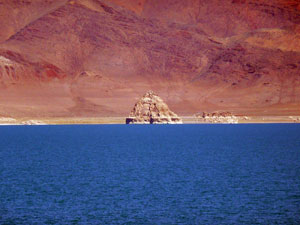
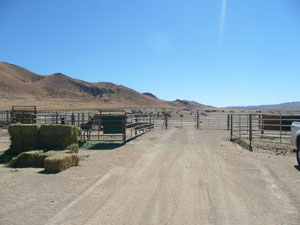
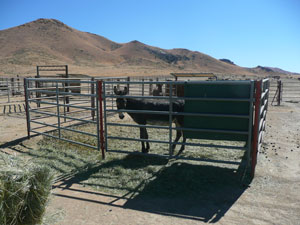
In the afternoon we had our first horse experience, a visit to the BLM's Palomino Valley Wild Horse and Burro Adoption Facility, also northeast of Reno. There are about 22,000 wild (feral, actually) horses out loose in Nevada and the BLM has established an Authorized Management Level of only 14,000, so they periodically go out and round up ("gather") thousands of them for eventual adoption, or sometimes relocation to preserve areas. This is one of many adoption/holding facilities. Cary Frost, the chief wrangler, gave us a tour in which we saw the holding pens and examined the equipment used for freeze-branding, vaccinating, and processing the animals. The branding is done with a brass "iron" that is dipped in liquid nitrogen, which painlessly causes the hair follicles to turn permanently white where it touches the neck. This brand is a unique registration number for each horse. There is an elaborate hydraulic contraption they call a "squeeze box" that gently holds the horse in position while this is going on. The horses all looked in relatively good shape and were not overcrowded, although they expected another 600 to arrive following day. Cary gave us the BLM explanation about the reasons for the limits on the horse population, which seemed sensible enough, although he gave us no real information about the practices during the gathering itself, for which he is not responsible. Information on adopting horses from the BLM can be found here.
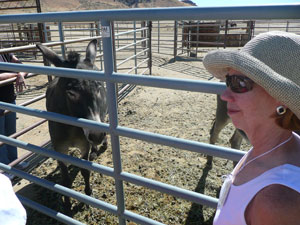

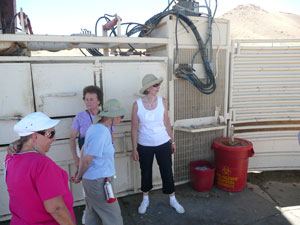
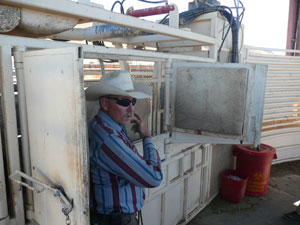
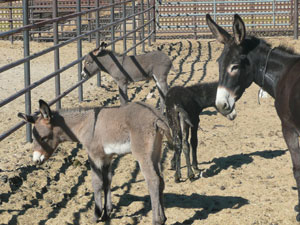
After dinner, the DVD Cloud was shown to the group; it's a very good documentary about the life of a wild colt, following him through his life as he grows up and becomes a stallion with his own herd of mares.
Friday
During breakfast we met Bonnie Matton of the Wild Horse Preservation League, who expressed her concern about the BLM practices, both the unrealistic authorized management levels as well as certain inhumane treatment during the gatherings. A number of people during the week were concerned about the recent gathering that was done during the winter, in which over 40 mares lost their foals in aborted pregnancies because of the stress.
We drove to the southeast of Virginia City to the tiny town of Dayton in the hopes of viewing some actual wild horse bands. We searched around for a while and spotted about 5 horses on a mountain that was probably 2 miles away, but then encountered a band of 8 much closer to us. By creeping up silently, we got within about 300 yards. We were able to see the dominant mare at the front of the column and the dominant stallion protecting the rear. Our photographs were not particularly good because of the distance, but we did not want to press our luck and get too close.
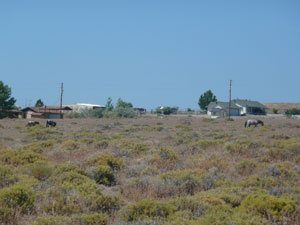
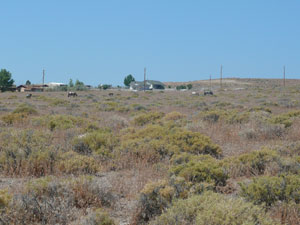
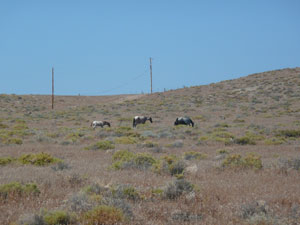
We spent the afternoon in Carson City, the capital of Nevada, a small, sleepy town. We had lunch at a little Italian restaurant and then visited the Nevada State Museum and the Nevada State Capitol. The museum was very informative and had good exhibits on Nevada history, the mining industry, geology, and wildlife. We were intrigued by the fossil of the prehistoric horse. Although the modern horses in North America were introduced by the Spanish conquistadors, apparently the equine species originated in North America and migrated to the rest of the world, only to become extinct here for reasons no one has figured out conclusively—it was either because of hunting by the native people or the dreaded phenomenon of "climate change." We took a guided tour of the capital and got to roam around in a variety of the executive offices and the now-abandoned Legislature and Senate chambers (which have since relocated to other buildings nearby).
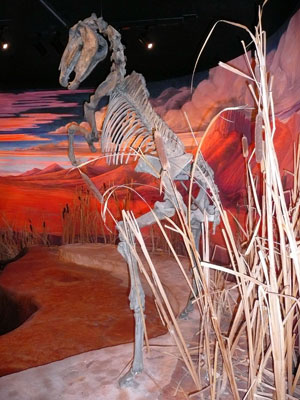
Prehistoric horse fossil at the
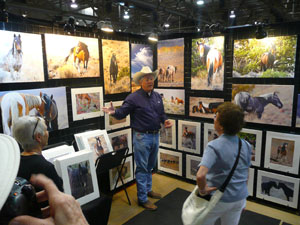
After dinner we met with Mark Terrell, the owner of Wild Horses of Nevada Photography. He was a very personable guy who told us a lot of stories about how he has been able to interact with the wild horse bands in the same area we visited that morning. He brought a number of large prints with him and we were all impressed at the quality of his photography and what great shots they were, particularly those that showed stallions fighting and tiny colts with their mothers. Mark expressed a more balanced view of the preservationist versus BLM controversies.
Saturday
We spent all day at the Western States Wild Horse and Burro Expo in downtown Reno. We first met with Cindy Lawrence, the lady who organized the 3-day event, which is focused on promoting the adoption of Mustangs. There were a variety of training sessions and demonstrations during the day; all the horses competing and showing were Mustangs. The highlight was interacting with some of the prisoners of the Nevada State Prison program that takes wild horses from the BLM and trains them for 120 days, after which they are put up for adoption. After visiting with some of them and their horses, we attended a competition between 10 of them, which was followed by an auction. Nancy's favorite of the group, Fantasma, was auctioned first and went for $2700 (in contrast to the $125 fee that BLM charges to adopt an untrained horse). He was the blue ribbon winner in all 3 of the prison program competitions. Disappointingly, the next horse up for auction went for only $200! We can imagine the feelings of a prisoner who spent 3 months training the horse for hours every day, only to have to give up the horse for a relative pittance. These horses are saddle trained, gentle and willing; some demonstrated riding bareback and without bridles, some stood on the horse's back, and all showed a willing and "broke" horse. Nancy came away from all of these Mustang interactions with a newfound appreciation of this kind of horse—hardy, resilient, and able to bond very strongly with the human. Some of the prisoners were close to tears when their horse was loaded on the trailer to be sent to his new home. But they've already started their next horse; the next auction takes place in Carson City in October.
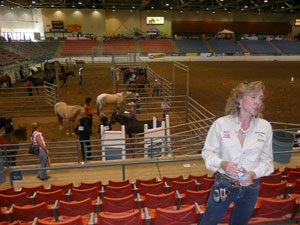
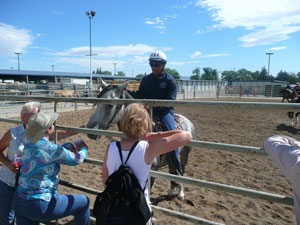
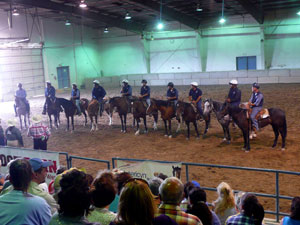
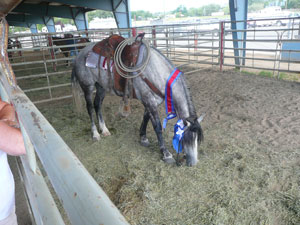
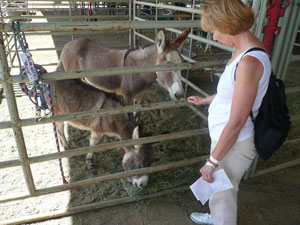
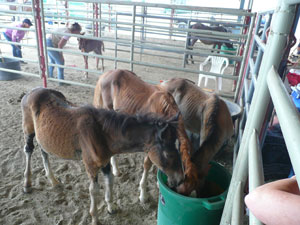
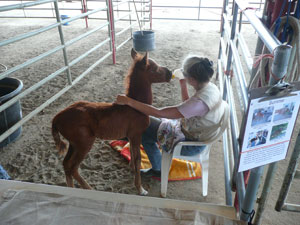
After the group went back to the hotel, Hal and Nancy returned to the Expo Center for the evening presentations, which were actually pretty lame. We're sure there were not more than 50 people in the audience. There were demonstrations of pony express riding techniques and a relatively new sport called Cowboy Mounted Shooting, in which a lady rode around as fast as she could, shooting balloons with 2 pistols loaded with wax pellets (blanks). There was also a horse who came out and sat down on a beanbag chair! There was supposed to be a demonstration of Lakota natives and their Mustangs, but apparently the horses did not have the appropriate health paperwork to enter Nevada, so one Lakotan used someone else's horse to give a demonstration of a sport with a lance, inspired by buffalo hunting. Since we missed the group dinner, we found a pizzeria that was part of a funky miniature golf course. It was recommended by locals on Yelp and we have to concur that the pizza was excellent. We also drove through the main part of downtown Reno, which was quite old-fashioned and downscale, with a number of abandoned storefronts and casinos.
Sunday
We drove a few miles north of Reno to visit a small facility called Horses for the Spirit, where troubled children are put through a training course that interacts with horses to improve their social abilities. They don't ride the horses, but go through a lengthy program of groundwork. This groundwork, which is inspired by Parelli's Natural Horsemanship techniques, is a series of 7 relatively simple interactions. We saw a demonstration of the techniques and Nancy and some of the other ladies got to experiment with using them on 3 of the horses: Otis, Lily, and Kiowa. Lily, a relatively young mare, entertained us by periodically aggressing against poor old Otis, a mild-mannered gelding.
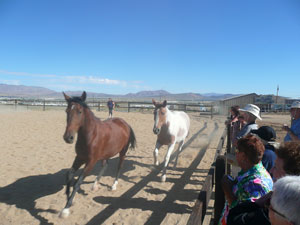
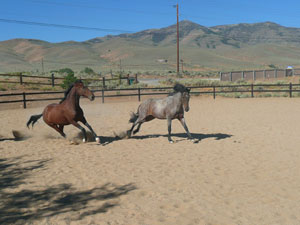
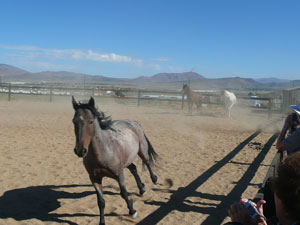

We headed toward Virginia City, first roaming around some neighborhoods on the way in the hope of seeing some more wild horses, but no luck. Highway 341 to Virginia City is extraordinarily scenic, climbing quickly to 6,700 feet at Geiger Pass, and then down to 6,200 feet. We had lunch on our own; a number of us selected a California/Mexican place called Café Del Rio, which was very good, although the portions were enormous. Afterward we had a guided tour through Piper's Opera House and the Fourth Ward school building. The latter, which at one time educated as many as 1,000 schoolchildren in a single four-story building, is now an interesting museum about the mining industry, printing technology, and Mark Twain. (Twain worked as a newspaper reporter in Virginia City. He also lectured at the Opera House, although it was an earlier version in a slightly different location, which burned prior to its rebuilding on its present site.) On the drive back, Hal was able to spot a lone wild horse about 500 yards from the road. The supposition was that it was a bachelor horse, ejected from a band, or else the rest of the band was behind a hill out of view.
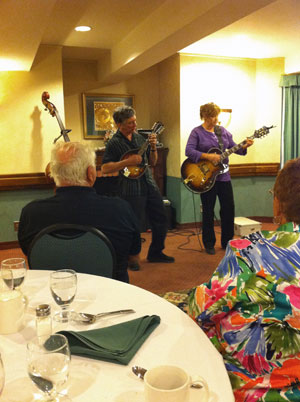
Our farewell dinner at the hotel included entertainment by the Roundabouts, a man and a woman who performed on guitar, mandolin, harmonica, and bass fiddle. They sang a number of tunes from the 1940s on through today, and some were familiar enough for us to sing along. It was a very enjoyable hour.
Monday
After a final breakfast, we bid our new friends goodbye and hit the road back to Redwood City. It was a great experience, even for Hal, who has only a middling interest in horses. We are looking forward to a future expedition with Road Scholar. And Nancy is thinking hard about a return trip to Reno for a future Mustang prison auction.